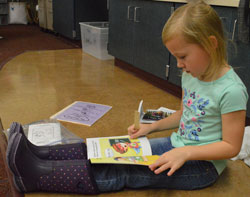There are new superheroes in town, and with the point of a popsicle stick, the zoom-in ability of hyper-focused eyes and ears, and the ability to know words in a “snap,” they are flying through their reading levels.
Districtwide, kindergartners are revealing their superhero personas during reading and writing lessons.
That’s when they activate powers like Pointer Power (following the words in a story with a stick), Re-read Power, Picture Power, Snap Word Power, Sound Power, Partner Power and Book Talk Power.

When faced with a formidable word, they use Persist Power, like Superman facing down kryptonite.
“What I like about Super Readers is they never give up on reading. They never say, ‘I can’t,'” said Countryside Elementary school kindergartner Connor Robinson.
Though he uses all his powers at school and at home, Connor is particularly fond of his Sound Power. “I love sounding out the words and hearing the sounds. It sounds like flowers blowing in the wind.”
Byron Center schools, including Brown, Marshall and Countryside elementaries, use a curriculum called The Teachers College Reading and Writing Project, developed by Lucy Calkins, which teachers have attended training for at Columbia University, in New York, over the past few years.

The superhero model gives the littlest learners something fun to relate to as they learn to read.
“It’s all those beginning reading strategies, but they are being taught to them like powers that they have,” said teacher Cindy Viveen. “They activate those powers when they read.”
Viveen said the model has helped Byron Center soar to the top. Countryside this fall joined Brown and Marshall as a National Blue Ribbon School winner, meaning all of the district’s elementary schools have received the honor in the past three years.
‘I love sounding out the words and hearing the sounds. It sounds like flowers blowing in the wind.’ — kindergartner Connor Robinson

Teachers start by presenting a mini-lesson on a power, and then have students practice them individually or with a partner, and then return to a group for sharing. It has given students a common language and structure for learning to read and write that they understand and enjoy.
About 95 percent of kindergartners were at or above grade level at the end of last school year.
“They are really light-years ahead,” Viveen said. “It’s incredible.”
CONNECT









